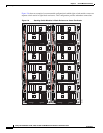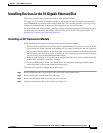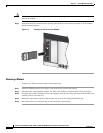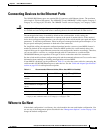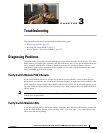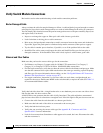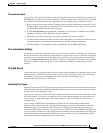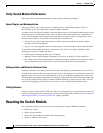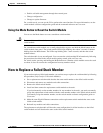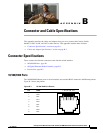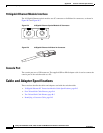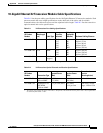
3-4
Catalyst Switch Module 3110G, 3110X, and 3012 for IBM BladeCenter Hardware Installation Guide
OL-12192-01
Chapter 3 Troubleshooting
Resetting the Switch Module
Verify Switch Module Performance
Review this section when troubleshooting switch module performance problems.
Speed, Duplex, and Autonegotiation
If the port statistics show a large amount of alignment errors, frame check sequence (FCS), or
late-collisions errors, this might mean a speed or duplex mismatch.
A common issue with speed and duplex is when the duplex settings are mismatched between two switch
modules, between a switch module and a router, or between the switch module and a workstation or
server. This can happen when manually setting the speed and duplex or from autonegotiation issues
between the two devices. A mismatch occurs under these circumstances:
• A manually set speed or duplex parameter is different from the manually set speed or duplex
parameter on the connected port.
• A port is set to autonegotiate, and the connected port is set to full duplex with no autonegotiation.
To maximize switch module performance and ensure a link, follow one of these guidelines when
changing the settings for duplex and speed:
• Let both ports autonegotiate both speed and duplex.
• Manually set the speed and duplex parameters for the ports on both ends of the connection.
• If a remote device does not autonegotiate, configure the duplex settings on the two ports to match.
The speed parameter can adjust itself even if the connected port does not autonegotiate.
Autonegotiation and Network Interface Cards
Problems sometimes occur between the switch module and third-party network interface cards (NICs).
By default, the switch module ports and interfaces are set to autonegotiate. It is common for devices like
laptops or other devices to be set to autonegotiate as well, yet sometimes autonegotation issues occur.
To troubleshoot autonegotiation problems, try manually setting both sides of the connection. If this does
not solve the problem, there could be a problem with the firmware or software on your NIC. You can
resolve this by upgrading the NIC driver to the latest version available from the manufacture.
Cabling Distance
If the port statistics show excessive FCS, late-collision, or alignment errors, verify that the cable distance
from the switch module to the connected device meets the recommended guidelines. See the
“Cable and
Adapter Specifications” section on page B-2 for cabling guidelines.
Resetting the Switch Module
For a standalone switch, you can perform these functions by using the AMM web interface:
• Reboot the switch
• Restore factory defaults
• Set or reset the IP address, netmask, and default gateway
• Enable or disable external ports



